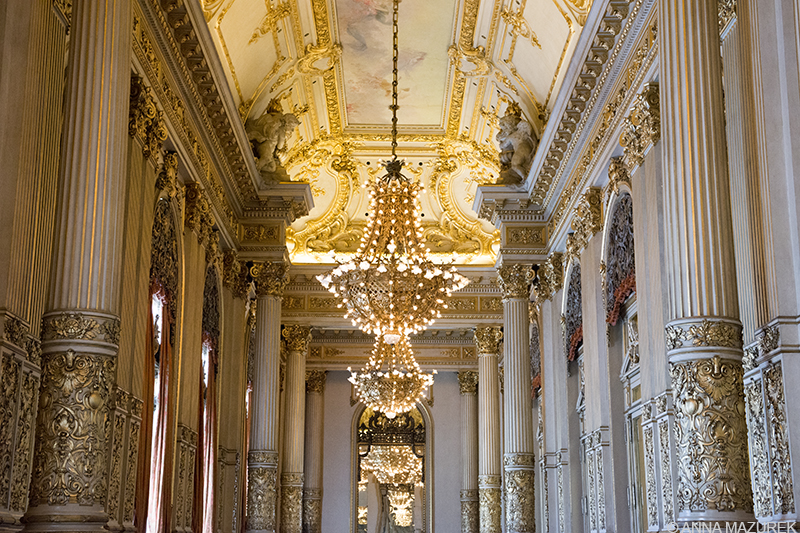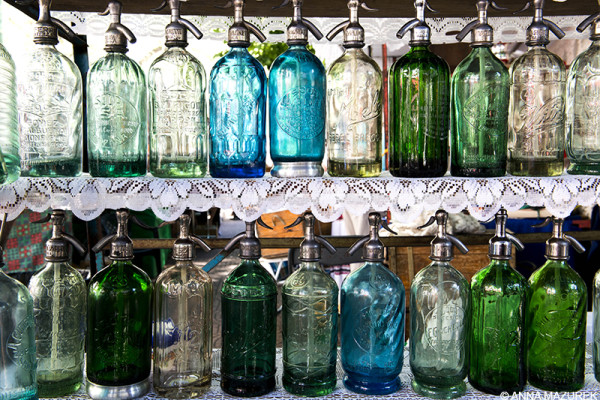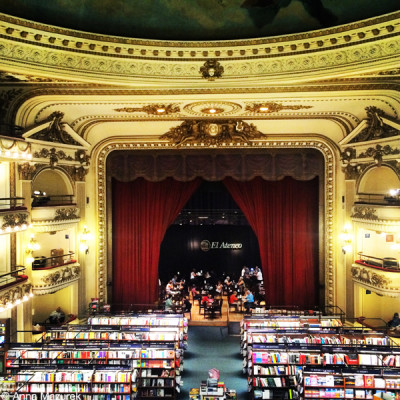
Teatro Colon is a stunning opera house in the heart of Buenos Aires. The performance seasons starts annually in March.
Is it possible to fall in love with a city?
Entirely possible. If you don’t believe me, I dare you to visit sexy, savory Buenos Aires. I rented an apartment ($35 USD/night) for a few weeks in March last year and hope to spend a few months there next year. The Argentinean capital is filled with European architecture and a Latin seductiveness that will tempt you to stay forever. Consider yourself warned.
Here are the six must-see sights in the city:
1. La Recoleta Cemetery
One of the most notable graves in La Recoleta Cemetery belongs to Eva Perón. The 14 acre grounds are hauntingly beautiful – elaborate aboveground marble mausoleums and statues cover a sprawling grid of four city blocks lined with large walkways. The cemetery was once the orchard for the adjacent 1732 Our Lady of Pilar church. Be sure to catch one of the free English tours at 11 a.m. on Tuesdays and Thursdays.
2. Teatro Colón
The seven-story Teatro Colón, pictured above, is not only one of the finest opera houses in the world but one of the most beautiful buildings in the city. Built in 1908, the theater covers an entire city block and features ballet, opera and concert performances. Many of the lavish building materials – Venetian mosaics, French stained glass and three kinds of Italian marble—were all imported from Europe. The main performance season started on March 1st. If you are unable to catch a performance, take one of the hourly guided tours to get a behind the scenes look at the stunning theater and rehearsal rooms.

Stalls of antique seltzer bottles are the heart of the San Telmo Market.
3. San Telmo Street Fair
Plan to be in Buenos Aires on a Sunday just to visit the street market in San Telmo. The heart of the market at Plaza Dorrego is focused more on antiques including a row of vendors selling vintage glass seltzer bottles. The stalls stretch out into the adjacent streets and eventually, it turns into more of a flea market with vendors selling leather belts, fresh squeezed juice and merchandise centered around Mafalda, a famous Argentinean cartoon character.
4. La Cabrera
A meal at La Cabrera is life changing. If you don’t have a reservation at the swanky Palermo parrilla (steakhouse), show up at 7 p.m. for happy hour. You will be seated promptly and everything (steak, salad and even wine) is 50% off. The only catch is that you must be out before 8 p.m. when they start seating parties with reservations. Juicy steaks are served with an array of small sides ranging from pickles to purees. Salads are gigantic, service is fast and you can take your bottle of wine to-go.

The most beautiful bookstore in the world: El Ateneo
5. El Ateneo Grand Splendid Bookstore
The story behind the bookstore is just as interesting as the décor. The building opened in 1919 as a theater called the Teatro Gran Splendid before converting into a cinema, which showed the first sound films in the country. The theater-turned-cinema was then converted into a bookstore in the early 2000s. Much of the interior including the ornate carvings remain in tact. Book shelves replaced the rows of seats, and the theater boxes were left for customers to curl up with a book. Dark red curtains frame the stage, which is now home to a quaint café. Their English book section is very limited.
6. National Museum of Decorative Arts
The 1917 beaux-art mansion was originally the home of Chilean aristocrat Matías Errázuriz and his wife, Josefina de Alvear. When Alvear died in 1935, the family donated the house and its extensive collection of European and Asian art to the Argentine government under the condition it be used as a museum. The elaborate décor features a ballroom with hand-carved ceilings along with artwork by Manet and Rodin. It is the only French mansion built at the beginning of the 20th century open to the public in Buenos Aires. Admission is free on Tuesdays. Stop for lunch at the adjacent Croque Madame Café for a delicious array of cakes and quiches before visiting the museum.
Best Times to Visit: January and February are peak season when both rates and temperatures soar. Fall (April – June) and spring (Sept.– Dec.) have milder temperatures (70-60° F) and smaller crowds. I personally love the heat so February and March were my favorite months to visit!
COMING UP: The Real Cost of Travel – A breakdown of all of my expenses (ranging from accommodation to beer to pay toilets) from my seven-month adventure in Latin America!

